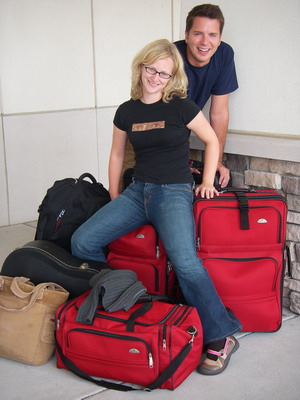 We were quite at home - and probably more ensconced than we'd realized - in Connecticut; and it's been more than a little unsettling to try to learn to navigate the vagaries of shopping for groceries and ordering coffee in our new surroundings. Aside from being unspeakably hip, our fellow Portland residents are admirably socially conscious and environmentally responsible. The streets are mobbed with cyclists and practically all of what's on offer in restaurants and our spectacular new grocery store is local, fair-trade, and organic; the city farmers' market is a vast thrice-weekly happening. We've been pleasantly humbled to find that so many of the leftist political positions we strove to adhere to back East are practically centrist here. Of course, sometimes, we Oregonians just go to the beach.
We were quite at home - and probably more ensconced than we'd realized - in Connecticut; and it's been more than a little unsettling to try to learn to navigate the vagaries of shopping for groceries and ordering coffee in our new surroundings. Aside from being unspeakably hip, our fellow Portland residents are admirably socially conscious and environmentally responsible. The streets are mobbed with cyclists and practically all of what's on offer in restaurants and our spectacular new grocery store is local, fair-trade, and organic; the city farmers' market is a vast thrice-weekly happening. We've been pleasantly humbled to find that so many of the leftist political positions we strove to adhere to back East are practically centrist here. Of course, sometimes, we Oregonians just go to the beach.
Before we get too settled, we thought it best to quantify the roadtrip experience that got us here:
- Days on the go: 18
- Miles under our belts: 4,118
- Blog posts: 10
- Locales in which we spent at least one night: 12
- Nights spent in the tent: 10
- Pictures taken: 449
- Postcards sent: 16
- National Parks / Monuments / Lakeshores / etc. visited: 7
We’ll be spending the coming months acquainting ourselves with the brewpub capital of the world (incidentally, Portland boasts the highest concentration of microbreweries anywhere, with 32 pubs in the city and 38 in the surrounding area) and the many regional totem pole sites. We may share a few new recipes and travel experiences around the Pacific Northwest, but for now, thanks for reading and come visit us in Stumptown!
More pictures of our exciting adventure in Oregon, so far, are available here:
 |

 This last leg of our trip was not without its own excitement. Our route followed the final portion of the original Oregon Trail through the Columbia River Gorge, which was thickly dotted with kite- and windsurfers. Rather thrillingly, our view of Mount Hood was intermittently obscured by the thick smoke of a huge wildfire that was burning near the town of Mosier. Undaunted by these inevitable hazards of western life, we glided into Portland by sunset, in plenty of time for a large salad of mixed greens and several pints of local beers at one of the many bars and clubs frequented by our tattooed, bearded, and bespectacled neighbors (and that's just the ladies).
This last leg of our trip was not without its own excitement. Our route followed the final portion of the original Oregon Trail through the Columbia River Gorge, which was thickly dotted with kite- and windsurfers. Rather thrillingly, our view of Mount Hood was intermittently obscured by the thick smoke of a huge wildfire that was burning near the town of Mosier. Undaunted by these inevitable hazards of western life, we glided into Portland by sunset, in plenty of time for a large salad of mixed greens and several pints of local beers at one of the many bars and clubs frequented by our tattooed, bearded, and bespectacled neighbors (and that's just the ladies).

 The culinary headline in Glacier is the wild huckleberry, a small blueberry-esque berry that is a favorite of grizzlies, especially when the great bears are in hyperphasia in preparation for their winter hibernation. The roads around the park are littered with restaurants and stands selling huckleberry-flavored everything, from jam to beer. After Tam choked down an only-just-mediocre huckleberry milkshake in Missoula, we stuck to snacking on the raw thing along the trail between intermittent grizzly-startling clapping and singing. The aspiring gastronomic etymologist will be interested to note that early American colonists, upon encountering the native American berry, misidentified it as the European berry known as the "hurtleberry," by which name the Yankee fruit was known until, through generations of slightly sloppy pronunciation, it became known as the "huckleberry." So, there you go, Mr. Finn.
The culinary headline in Glacier is the wild huckleberry, a small blueberry-esque berry that is a favorite of grizzlies, especially when the great bears are in hyperphasia in preparation for their winter hibernation. The roads around the park are littered with restaurants and stands selling huckleberry-flavored everything, from jam to beer. After Tam choked down an only-just-mediocre huckleberry milkshake in Missoula, we stuck to snacking on the raw thing along the trail between intermittent grizzly-startling clapping and singing. The aspiring gastronomic etymologist will be interested to note that early American colonists, upon encountering the native American berry, misidentified it as the European berry known as the "hurtleberry," by which name the Yankee fruit was known until, through generations of slightly sloppy pronunciation, it became known as the "huckleberry." So, there you go, Mr. Finn.

























